Performing arts
This article needs additional citations for verification. (May 2018) |
| Part of a series on |
| Performing arts |
|---|

The performing arts are
Live performances before an audience are a form of entertainment. The development of audio and video recording has allowed for private consumption of the performing arts. The performing arts often aims to express one's emotions and feelings.[2]
Performers
Artists who participate in performing arts in front of an audience are called performers. Examples of these include

Types
Performing arts may include dance, music, opera, theatre and musical theatre,
.There is also a specialized form of fine art, in which the artists perform their work live to an audience. This is called
Theatre
Theatre is the branch of performing arts concerned with acting out stories in front of an audience, using a combination of speech, gesture, music, dance, sound, and spectacle. Any one or more of these elements is considered performing arts. In addition to the standard narrative dialogue style of plays, theater takes such forms as plays, musicals, opera, ballet,
Dance
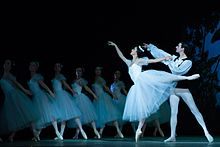
In the context of performing arts, dance generally refers to human
There is one another modern form of dance that emerged in 19th- 20th century with the name of
Dance is a powerful impulse, but the art of dance is that impulse channeled by skillful performers into something that becomes intensely expressive and that may delight spectators who feel no wish to dance themselves. These two concepts of the art of dance—dance as a powerful impulse and dance as a skillfully choreographed art practiced largely by a professional few—are the two most important connecting ideas running through any consideration of the subject. In dance, the connection between the two concepts is stronger than in some other arts, and neither can exist without the other.[4]
Choreography is the art of making dances, and the person who practices this art is called a choreographer.
Music
Music is an art form which combines pitch, rhythm, and dynamic to create sound. It can be performed using a variety of instruments and styles and is divided into genres such as folk, jazz, hip hop, pop, and rock, etc. As an art form, music can occur in live or recorded formats, and can be planned or improvised.
As music is a protean art, it easily coordinates with words for songs as physical movements do in dance. Moreover, it has a capability of shaping human behaviors as it impacts our emotions.[6]
History
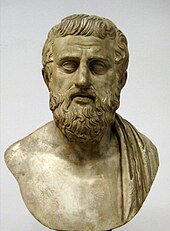
Western performing arts
Starting in the 6th century BC, the
However, by the 6th century AD, Western performing arts had been largely ended as the
Renaissance
In the 15th century performing arts, along with the arts in general, saw a revival as the Renaissance began in Italy and spread throughout Europe plays, some of which incorporated dance, which were performed and Domenico da Piacenza credited with the first use of the term ballo (in De Arte Saltandi et Choreas Ducendi) instead of danza (dance) for his baletti or balli. The term eventually became Ballet. The first Ballet per se is thought to be Balthasar de Beaujoyeulx's Ballet Comique de la Reine (1581).
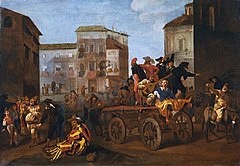
By the mid-16th century
In 1597, the first opera, Dafne was performed and throughout the 17th century, opera would rapidly become the entertainment of choice for the aristocracy in most of Europe, and eventually for large numbers of people living in cities and towns throughout Europe.
Modern era
The introduction of the
It is also during this time that the first plays were performed in the American Colonies.
During the 18th century, the introduction of the popular opera buffa brought opera to the masses as an accessible form of performance. Mozart's The Marriage of Figaro and Don Giovanni are landmarks of the late 18th century opera.
At the turn of the 19th century,
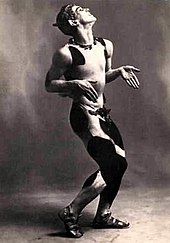
The 19th century was a period of growth for the performing arts for all social classes, technical advances such as the introduction of gaslight to theatres, burlesque, minstrel dancing, and variety theatre. In ballet, women make great progress in the previously male-dominated art.
Modern dance began in the late 19th century and early 20th century in response to the restrictions of traditional ballet. The arrival of Sergei Diaghilev's Ballets Russes (1909–1929) revolutionized ballet and the performing arts generally throughout the Western world, most importantly through Diaghilev's emphasis on collaboration, which brought choreographers, dancers, set designers/artists, composers and musicians together to revitalize and revolutionize ballet. It is extremely complex.
With the invention of the motion picture in the late 19th century by Thomas Edison and the growth of the motion picture industry in Hollywood in the early 20th century, film became a dominant performance medium throughout the 20th and 21st centuries.
Rhythm and blues, a cultural phenomenon of black America, rose to prominence in the early 20th century, influencing a range of later popular music styles internationally.
Postwar
Post-World War II performing arts were highlighted by the resurgence of both ballet and opera in the Western world.
Postmodernism dominated the performing arts during the 1970s and the 1980s.[7]
African performing arts
This section needs expansion. You can help by adding to it. (February 2021) |
Indigenous African performance traditions are rooted in ritual, storytelling, movement, and music.[8] Performances were communal with the storytellers and audience interacting and participating in call and response, which is characterized by a vocalist signing a phrase that is then echoed or responded to with a new phrase by the other performers and/or audience. This ancient tradition is rooted in many African cultures.[9]
North Africa
The earliest recorded theatrical event dates back to 2000 BC with the ceremonial plays of Ancient Egypt. The story of the god Osiris was performed annually at festivals throughout the civilization, marking the known beginning of a long relationship between theatre and religion. The Dramatic Ramesseum Papyrus, the oldest surviving illustrated papyrus details the performance during the Sed Festival and has been used as evidence of the birth of theatrical tradition, which western scholars often attribute to ancient Greece.[10]
West Africa
A Griot is a West African oral historian who uses storytelling, poetry, and music to express the genealogies and historical narratives of the tribes they represent, often playing instruments such as the kora.[11] This ancient profession is upheld in a position of community leadership.
Eastern performing arts
West Asia
The most popular forms of theater in the

Iran
In
India
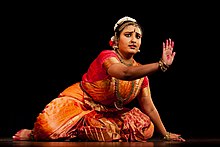
Folk theatre and dramatics can be traced to the religious ritualism of the
The Ramayana and Mahabharata can be considered the first recognized plays that originated in India. These epics provided the inspiration to the earliest Indian dramatists and they do it even today. Indian dramatists such as Bhāsa in the 2nd century BC wrote plays that were heavily inspired by the Ramayana and Mahabharata.[citation needed]
The next great Indian dramatist was
]There were many performing art forms in the southern part of India, Kerala is such a state with different such art forms like Koodiyattam, Nangyarkoothu, Kathakali, Chakyar koothu, Thirayattam and there were many prominent artists like Painkulam Raman Chakyar and others.[citation needed]
China

There are references to theatrical entertainments in China as early as 1500 BC during the Shang dynasty; they often involved music, clowning and acrobatic displays.[16]
The Tang dynasty is sometimes known as "The Age of 1000 Entertainments". During this era,
During the Han Dynasty,
In the
Thailand
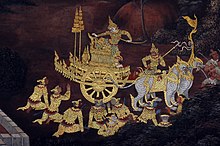
In Thailand, it has been a tradition from the Middle Ages to stage plays based on plots drawn from Indian epics. In particular, the theatrical version of Thailand's national epic Ramakien, a version of the Indian Ramayana, remains popular in Thailand even today.
Cambodia
In
Philippines
In the
The
All of these literary pieces were under the curriculum of the
Japan


During the 14th century, there were small companies of actors in
Japan, after a long period of civil wars and political disarray, was unified and at peace primarily due to shōgun Tokugawa Ieyasu (1600–1668). However, alarmed at the increasing numbers of Christians within the country due to the proselytizing efforts of Christian missionaries, he cut off contact from Japan to Europe and China and outlawed Christianity. When peace did come, a flourish of cultural influence and growing merchant class demanded its own entertainment. The first form of theatre to flourish was Ningyō jōruri (commonly referred to as Bunraku). The founder of and main contributor to Ningyō jōruri, Chikamatsu Monzaemon (1653–1725), turned his form of theatre into a true art form. Ningyō jōruri is a highly stylized form of theatre using puppets, today about 1⁄3rd the size of a human. The men who control the puppets train to become master puppeteers, when they can then operate the puppet's head and right arm and choose to show their faces during the performance. The other puppeteers, controlling the less important limbs of the puppet, cover themselves and their faces in a black suit, to imply their invisibility. The dialogue is handled by a single person, who uses varied tones of voice and speaking manners to simulate different characters. Chikamatsu wrote thousands of plays during his lifetime, most of which are still used today.[citation needed]
Kabuki began shortly after Bunraku, legend has it by an actress named Okuni, who lived around the end of the 16th century. Most of kabuki's material came from Noh and Bunraku, and its erratic dance-type movements are also an effect of Bunraku. However, kabuki is less formal and more distant than Noh, yet very popular among the Japanese public. Actors are trained in many varied things including dancing, singing, pantomime, and even acrobatics. Kabuki was first performed by young girls, then by young boys, and by the end of the 16th century, kabuki companies consisted of all men. The men who portrayed women on stage were specifically trained to elicit the essence of a woman in their subtle movements and gestures.[citation needed]
History of performing arts in the Americas
This section needs expansion. You can help by adding to it. (February 2021) |
History of performing arts in Oceania
This section needs expansion. You can help by adding to it. (February 2021) |
Oftentimes, Melanesian dance exhibits a cultural theme of masculinity where leadership and a unique skill set are important for sharing with the community.[19] These dances demonstrate the soldiery of a man; however they can also represent profitability such as encouraging conflict resolutions or healing.[20] The costumes of impersonating dancers incorporate large masks and unhuman-like characteristics that act to imitate mythical figures. The music can also act as a voice for these magical personas.[19]
See also
- Entertainment
- Outline of performing arts
- Performing arts education
- Performing arts presenters
- United States copyright law in the performing arts
- Pamela D, Franklin Cultural Center for the Performing Arts
- Persian theatre
- Theatre of Japan
- Western culture
References
- ^ "the-performing-arts noun – Definition, pictures, pronunciation and usage notes | Oxford Advanced Learner's Dictionary at OxfordLearnersDictionaries.com". www.oxfordlearnersdictionaries.com. Archived from the original on 30 July 2022. Retrieved 19 January 2021.
- S2CID 145689520.
- ^ Mackrell, Judith R. (19 May 2017). "dance". Encyclopædia Britannica, Inc. Archived from the original on 7 October 2019. Retrieved 14 July 2017.
- ^ a b Mackrell, Judith. "Dance". Encyclopædia Britannica. Archived from the original on 24 March 2015. Retrieved 11 March 2015.
- ^ Nana, Loria (30 June 2015). "Philosophical Context of Contemporary Choreographic Space" (PDF). GESJ: Musicology and Cultural Science. 11 (1): 64–67. Archived (PDF) from the original on 3 January 2023. Retrieved 3 January 2023.
- ^ Epperson, Gordan (11 April 2016). "music". Encyclopædia Britannica, Inc. Archived from the original on 28 October 2019. Retrieved 14 July 2017.
- ^ Auslander, Philip (28 May 2006). The Cambridge Companion to Postmodernism (PDF). Cambridge University Press. p. 98.
- ^ "African Traditional Theater or Unknown Performances". quasianonima.it (in Italian). Archived from the original on 25 January 2023. Retrieved 25 January 2023.
- ^ Katie. "The Call And Response In African Culture". brightstarmusical.com. Archived from the original on 25 January 2023. Retrieved 25 January 2023.
- from the original on 25 January 2023. Retrieved 25 January 2023.
- ^ "Griot | African troubadour-historian | Britannica". www.britannica.com. Archived from the original on 7 March 2023. Retrieved 25 January 2023.
- ISBN 978-1-0152-8641-2.
- ISBN 0-8147-1375-0.
- ISBN 978-965-264-014-7.
- ProQuest 209398361.
- ^ ISBN 978-1-135-04113-7. Archivedfrom the original on 29 June 2023. Retrieved 29 June 2023.
- ^ "the-noh.com : The Words of Zeami : His Dramatic Life". www.the-noh.com. Archived from the original on 11 March 2022. Retrieved 19 September 2021.
- OCLC 1211914.[page needed]
- ^ a b "Oceanic music and dance". Encyclopedia Britannica. Archived from the original on 8 October 2021. Retrieved 2 October 2021.
- ProQuest 222380632.
